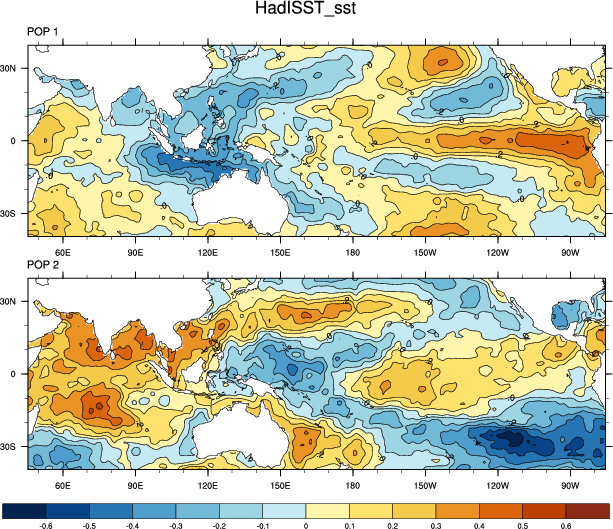NCL version 6.2.0 or higher is required to use the code below.
This is user donated code. It is not supported by the NCL developers. Questions and comments can be sent to ncl-talk@ucar.edu. However, responses are not guaranteed.
Example pages containing: tips | resources | functions/procedures


NCL version 6.2.0 or higher is required to use the code below.
This is user donated code. It is not supported by the NCL developers. Questions and comments can be sent to ncl-talk@ucar.edu. However, responses are not guaranteed.
The scripts below are intended to be 'guide' to usage. They may work directly but, generally, the user will have to make some changes to the scripts. The code can generate a user specified number of POPs.
The following libraries must be loaded prior to use.
load "$NCARG_ROOT/lib/ncarg/nclscripts/csm/gsn_code.ncl" load "$NCARG_ROOT/lib/ncarg/nclscripts/csm/gsn_csm.ncl" load "$NCARG_ROOT/lib/ncarg/nclscripts/csm/contributed.ncl" ; download the following by clicking on the text load "PrnOscPat_driver.ncl" load "pltEofPop.ncl" load "pltClim.ncl"
********************* REFERENCES *********************von Storch, Hans, Gerd Berger, Reiner Schnur, Jin-Song von Storch, 1995: Principal Oscillation Patterns: A Review. J. Climate, 8, 377–400
Gehne et al (2014): Irregularity and decadal variation in ENSO: A simplified model based on Principal Oscillation Patterns. Climate Dynamics, 43:3327-3350 ***************************************************
Excerpts from the von Storch et al (1995) reference:
"The principal oscillation pattern (POP) analysis is a multivariate technique used to simultaneously infer the characteristic patterns and times cales of a vector time series. The POPs may be seen as the normal modes of a linearized system whose system matrix is estimated from data. [snip] The basic idea is to identify a linear system with a few free parameters that are fitted to the data. Then, the space-time characteristics of this simple system is regarded as being the same as those of the full system. [snip] The POP method is not a tool that is useful in all applicaations. If the analyzed vector time series exhibit a strongly nonlinear behavior, the POPs may fail to identify a useful subsystem. However, if a significant portion of the variability of a nonlinear system is controlled by linear dynamics, the POP analysis may be successful in extracting principal modes of oscillation."

 prn_osc_pat_1.ncl:
prn_osc_pat_1.ncl:
This performs a POP analysis on Hadley Center monthly sea surface temperatures. The data may be downloaded from: http://www.metoffice.gov.uk/hadobs/hadisst. (You may have to register.)